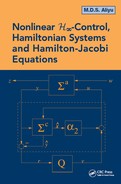Preface
This book is about nonlinear -control theory, Hamiltonian systems, and Hamilton-Jacobi equations. It is the culmination of one decade of the author’s endeavors on the subject, and is addressed to practicing professionals, researchers and graduate students interested in optimal and robust control of nonlinear systems. The prerequisites for understanding the book are graduate-level background courses in linear systems theory and/or classical optimal control, or calculus of variation; linear algebra; and advanced calculus. It can be used for a specialized or seminar course in robust and optimal control of nonlinear systems in typical electrical, mechanical, aerospace, systems/industrial engineering and applied mathematics programs. In extreme cases, students from management and economics can also benefit from some of the material.
The theory of nonlinear -control which started around 1990, almost a decade after Zames’ formulation of the linear theory, is now complete. Almost all the problems solved in the linear case have been equivalently formulated and solved for the nonlinear case; in most cases, the solutions are direct generalizations of the linear theory, while in some other cases, the solutions involve more sophisticated tools from functional analysis and differential games. However, few challenging problems still linger, prominent among which include the long-standing problem of how to efficiently solve the Hamilton-Jacobi equations, which are the cornerstones of the whole theory. Nevertheless, the enterprise has been successful, and by-and-large, the picture is complete, and thus the publishing of this book is timely.
The authors’ interest in nonlinear control systems and the -control problem in particular, was inspired by the pace-setting book of Prof. H. K. Khalil, Nonlinear Systems, Macmillan Publishing Company, 1992, which he used for a first graduate course in nonlinear systems, and the seminal paper, “-Gain Analysis of Nonlinear Systems and Nonlinear State-Feedback -Control,” IEEE Transactions on Automatic Control, vol. 37, no. 6, June, 1992, by Prof. A. J. van der Schaft. The clarity of the presentations, qualitative exposition, and the mathematical elegance of the subject have captivated his love, interest, and curiosity on the subject which continues till today.
The book presents the subject from a traditional perspective, and is meant to serve as a self-contained reference manual. Therefore, the authors have endeavored to include all the relevant topics on the subject, as well as make the book accessible to a large audience. The book also presents the theory for both continuous-time and discrete-time systems, and thus it is anticipated that it will be the most comprehensive on the subject.
A number of excellent texts and monographs dealing entirely or partially on the subject have already been published, among which are
1. -Optimal Control and Related Minimax Design Problems, by T. Basar and P. Bernhard, 2nd Ed., Systems and Control: Foundations and Applications, Birkhauser, 1996;
2. Feedback Design for Discrete-time Nonlinear Control Systems, by W. Lin and C. I. Byrnes, Systems and Control: Foundations and Applications, Birkhauser, 1996;
3. Nonlinear Control Systems, by A. Isidori, 3rd Ed., Springer Verlag, 1997;
4. Extending -Control to Nonlinear Systems, by J. W. Helton and M. R. James, SIAM Frontiers in Applied Mathematics, 1999;
5. -gain and Passivity Techniques in Nonlinear Control, by A. J. van der Schaft, Springer Verlag, 2nd Ed., 2000.
However, after going through the above texts, one finds that they are mostly written in the form of research monographs addressed to experts. Most of the details and the nitty-gritty, including topics on the basics of differential games, nonlinear -filtering, mixed / nonlinear control and filtering, and singular nonlinear -control, are not discussed at all, or only touched briefly. Also, algorithms for solving the ubiquitous Hamilton-Jacobi equations as well as practical examples have not been presented.
It is thus in the light of the above considerations that the author decided to summarize what he has accumulated on the subject, and to complement what others have already done. However, in writing this book, the author does not in any way purport that this book should outshine the rest, but rather covers some of the things that others have left out, which may be trivial and unimportant to some, but not quite to others. In this regard, the book draws strong parallels with the text [129] by Helton and James at least up to Chapter 7, but Chapters 8 through 13 are really complementary to all the other books. The link between the subject and analytical mechanics as well as the theory of partial-differential equations is also elegantly summarized in Chapter 4. Moreover, it is thought that such a book would serve as a reference manual, rich in documented results and a guide to those who wish to apply the techniques and/or delve further into the subject.
The author is solely responsible for all the mistakes and errors of commission or omission that may have been transmitted inadvertently in the book, and he wishes to urge readers to please communicate such discoveries whenever and whereever they found them preferably to the following e-mail address: [email protected]. In this regard, the author would like to thank the following individuals: Profs. K. Zhou and L. Smolinsky, and some anonymous referees for their valuable comments and careful reading of the manuscript which have tremendously helped streamline the presentation and reduce the errors to a minimum. The author is also grateful to Profs. A. Astolfi and S. K. Nguang for providing him with some valuable references.
M. D. S. Aliyu
Montréal, Québec
